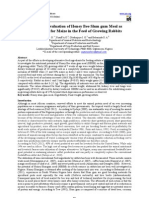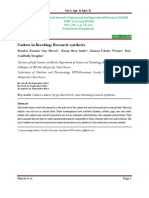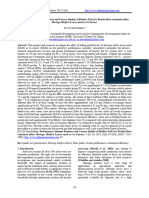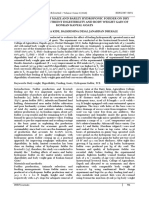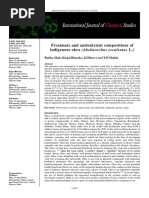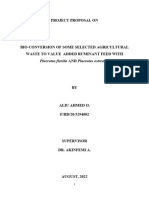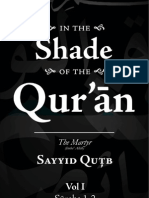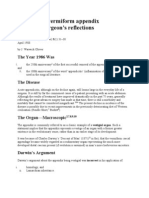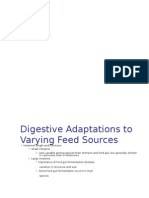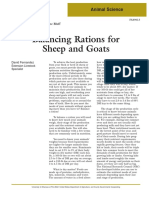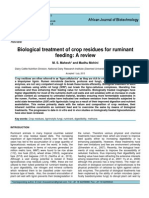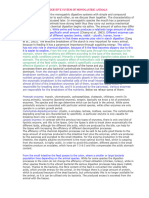Nutrient Utilization and Growth Performance of West African Dwarf Goats Fed With Elephant Grass or Different Proportions of Plantain and Mango Peels
Nutrient Utilization and Growth Performance of West African Dwarf Goats Fed With Elephant Grass or Different Proportions of Plantain and Mango Peels
Uploaded by
Chern YuanCopyright:
Available Formats
Nutrient Utilization and Growth Performance of West African Dwarf Goats Fed With Elephant Grass or Different Proportions of Plantain and Mango Peels
Nutrient Utilization and Growth Performance of West African Dwarf Goats Fed With Elephant Grass or Different Proportions of Plantain and Mango Peels
Uploaded by
Chern YuanCopyright
Available Formats
Share this document
Did you find this document useful?
Is this content inappropriate?
Copyright:
Available Formats
Nutrient Utilization and Growth Performance of West African Dwarf Goats Fed With Elephant Grass or Different Proportions of Plantain and Mango Peels
Nutrient Utilization and Growth Performance of West African Dwarf Goats Fed With Elephant Grass or Different Proportions of Plantain and Mango Peels
Uploaded by
Chern YuanCopyright:
Available Formats
World Journal of Agricultural Sciences Vol. 1 (6), pp. 194-202, July 2013 Available online at http://wsrjournals.
org/journal/wjas ISSN 2329-93122013 World Science Research Journals
Full Length Research Paper
Nutrient utilization and growth performance of West African Dwarf goats fed with elephant grass or different proportions of plantain and mango peels.
M. I. Okoruwa1, M. K. Adewumi2 and A. A. Njidda3
1
Department of Animal Science, Ambrose Alli University, P.M.B. 14, Ekpoma, Edo State, Nigeria. 2 Department of Animal Science, University of Ibadan, Ibadan, Nigeria. 3 Department of Animal Science, Bayero University, P.M.B. 3011, Kano State, Nigeria.
Accepted June 24, 2013
Eighteen West African dwarf goats balanced for weight (6.000.57 kg) were fed with elephant grass and different proportions of dried plantain with mango peels to evaluate their intake, growth rate, nitrogen and energy utilization. Goats were assigned to three dietary treatments in a completely randomized design with six goats per treatment. The compared dietary treatments were as follows; T A (elephant grass and concentrate in a ratio of 63:32), T B and TC (combination of dried plantain with mango peels and concentrates in a ratio of 55:13:32 and 50:18:32 respectively). The results showed that TA was significantly (P<0.05) best in crude fibre intake (67.51 g/day), neutral and acid detergent fibre intake (49.01 and 29.58 g/day), urinary nitrogen output 3.62 g/day), faecal and total energy output (185.25 and 220.45 Kcal/g/day). Ether extract intake (9.92g/day) was significantly (P<0.05) highest in T B compared to TA and TC. The total (23970 g) and daily (285.36 g/day) feed intake, average daily feed intake (15.83 0.75 g/day), final body weight (9384.00 g), daily weight gain (33.67 g and 13.98 BW ), nitrogen intake 0.75 (21.75g/day), faecal nitrogen output (10.09 g/day), nitrogen balance (9.37 g/day and 5.36 BW ), nitrogen retention (0.43 g/day and 43.08%), gross energy intake (1896.02 Kcal/g/day), digestible energy 0.75 intake (90.59 Kcal/g/day) and metabolizable energy intake (82.21 Kcal/g/day and 27.30 BW ) were highest in TC and significantly differed from the other treatments. Significant differences (P>0.05) did not occur in organic matter intake, feed conversion ratio, metabolizability and ME:DE ratio among the treatment groups. It is concluded that dried plantain with mango peels and concentrate in a ratio of 50:18:32 has the potential to enhance nutrient utilization and growth performance of West African dwarf goats. Key words: Plantain peels, mango peels, nutrient utilization, dwarf goats.
INTRODUCTION Ruminant livestock plays an important role in the economic development of Nigeria in terms of feeding the steadily growing population and providing the investible resources for national development. Goats are classified as an important small ruminant on account of their unique ability to adapt and maintain themselves in harsh environment. Their small size relative to cattle contributes to their wide distribution and easy management among
*Corresponding author. E-mail: odionokos@yahoo.com.
Okoruwa et al.
195
farmers. They are considered superior to other ruminant species in their utilization of poor quality and high fibre feeds (Oyeyemi and Akusu, 2005). They are mostly kept for sources of meat, milk and skin production. Other purposes of keeping goats include household income, festival season and special occasions (Odeyinka and Okunade, 2005). Despite the various efforts made by the government, returns to the economy from small ruminant livestock sector have been very much below the potential (Sanni et al., 2003). The major factors contributing to this problem include inadequate feeding and low productivity. The combined weight of these draw back factors has led to the sub-optimal utilization of the available ruminant products. Goats in Nigeria suffer several nutritional stresses in the dry season as a result of seasonal variability that affects the availability and nutritive quality of pastures which in turn marked decrease in nutrient intake and utilization. Small ruminant feeds requirement in the tropics is aggravated by high cost of conventional feeds and lack of alternative source of feed particularly during the dry season when forages are scarce (Okoruwa and Adewumi, 2010). This has necessitated the need to search for alternative sources that are cheaper and readily available. Mango is the most important fruit crop in the tropics after bananas and plantains (FAO, 2011). The processing yields about 40 to 50% of by-products left behind after the edible portion has been processed into various food items (Sruamsiri and Silman, 2009). Plantain (Musa paradisiaca) and Mango (Mangifera indica) are believed to have originated in Asia and India respectively. Their peels are always discarded as waste which constitute nuisance in waste disposal of processing industries in Nigeria. This at present is posing a problem to health hazard to humans particularly in the vicinity of the processing points. The use of plantain with mango peels as an alternative source of feed has been identified to play an important role in livestock nutrition (Omole et al., 2004). These peels are classified among other agroindustrial by-products that can be utilized to a great advantage for ruminants in Nigeria. Dried plantain and mango peels have been reported in literatures (Sanon and Kanwe, 2010; Ogunsipe and Agbede, 2010) as energy feed for livestock but low in protein content and the addition of a source of nitrogen or protein is necessary to allow an efficient utilization of these peels in the diet. Though the utilization of these peels by ruminants are available in literature (Azevedo et al., 2011), there is still a paucity of information on the combination of these peels as replacement for elephant grass by West African Dwarf (WAD) goats. Hence the objective of this present study is to compare the feed intake, nutrient utilization and growth performance of WAD goats fed with elephant grass against different plantain and mango peels combinations.
MATERIALS AND METHODS Experimental site The experiment was conducted at the sheep and goats unit of the Teaching and Research Farm, Ambrose Alli University, Ekpoma, Edo State, Nigeria. Ekpoma is located in the Northern-east of Edo State (Longitude 6.09E and Latitude 6.42N) with a unimodal rainfall pattern which starts from April to October and average of 1556mm per annum. The average ambient temperature was about 30C per annum.
Experimental diets and design The elephant grass was harvested at the pre-anthesis stage from the Teaching and Research Farm and manually chopped into small sizes of 4 cm. Plantain and mango peels were collected fresh from their processing centre located within Ekpoma metropolis. They were chopped and immediately dried under shade for several days before milled. The composition of the purchased concentrate diet were as followed: 78% what offal, 20% brewery dried grain, 0.75% limestone, 0.5% dicalcium phosphate, 0.5% salt and 0.25% vitamin premix respectively. Elephant grass and dried plantain with mango peels constituted the basal diets. The experimental diets consisted of basal and concentrate supplement which were offered at the rate of 5% (DM basis) of their body weight in a proportion of 68:32 respectively. Three comparative experimental diets were formulated and designated A, B and C. Diet A which was the control group constituted elephant grass and concentrate in a ratio of 63:32. Diets B and C comprised combination of dried plantain with mango peels and concentrate in ratios of 55:13:32 and 50:18:32 respectively. The experimental animals were weighed before the commencement of the study and randomly allocated to the three dietary treatments in a completely randomized design. Each treatment was replicated with six animals.
Experimental animals and management Eighteen (18) growing WAD goats (bucks), aged between 6 and 7 months with average initial body weight of 6.000.57 kg were used for the experiment. The experimental animals were purchased at a local market within Ekpoma. On arrival, the WAD goats were given prophylactic treatments against ecto and endo parasites and drenched with Albendazole which lasted for 21 days before they were later allotted to demarcated individual pens. The goats were housed in open sided, well-lighted and adequately ventilated building with slightly sloppy concrete floor. The concrete floor was covered with 5 cm
World J. Agric. Sci. 196
Table 1. Proximate chemical (%DM) and gross energy (Kcal/g) composition of the basal and supplementary diets.
Parameters Dry matter Crude protein Ether extract Crude fibre Ash Nitrogen free extract Neutral detergent fibre Acid detergent fibre Gross energy
EG 86.75 8.12 1.15 29.55 10.95 50.23 68.02 32.10 3.85
Basal diets PL 88.90 7.92 1.24 5.81 6.52 78.51 24.04 18.32 4.04
MP 87.52 9.14 0.42 5.24 3.34 81.86 22.15 16.25 4.16
Concentrate supplement (CS) 85.24 19.98 1.06 12.06 7.95 58.95 66.00 23.11 4.15
EG = Elephant grass, PL = Plantain peel, MP = Mango peel, CS = Concentrate supplement.
layers of wood shavings to absorb urine and for easy removal of faeces. The pens were cleaned daily and wood shavings were changed fortnightly. Basal and concentrate feeds were fed to goats at 8.00am in the morning with concentrate first followed by basal diet. Mineral salt lick and water were provided ad libitum to the animals throughout the experimental period. The daily feed intake was determined by the difference in weight in the quantity of feed provided and the residue of the previous days feed or leftovers. Sub-samples of feeds offered were oven dried at 105C to constant weight or dry matter determination. They were milled using the Christy Norris hammer mill fitted with a 2 mm sieve. Dried samples were stored in air-tight bottles for analysis. Weighing of the goats were carried out by using hanging scale on weekly basis before the morning feeds were offered to determine weight gain. Data derived from daily feed intake and daily weight gain was computed and feed conversion ratio was calculated as the ratio of feed intake over the body weight gain.
through methane was set at 5% of the gross energy intake (CSIRO, 2001). Nitrogen balance by the animals was calculated as the difference between nitrogen intake and nitrogen excreted from faeces and urine while nitrogen retention percentage was computed from nitrogen balance expressed as a percentage of nitrogen intakes.
Chemical analysis Samples of the experimental diets offered and faecal outputs were analysed for proximate composition using the procedures of AOAC (1990). Neutral detergent fibre and acid detergent fibre of the samples were determined as prescribed by Van Soest et al. (1991). Urine samples were analyzed for nitrogen using AOAC (1990).
Statistical analysis Data obtained on intake, growth rate, energy and nitrogen utilization parameters were subjected to analysis of variance (ANOVA) to determine the significance of treatment effects following the methods described by SAS (1999).
Energy and nitrogen utilization studies Five (5) WAD goats per treatment (totalling 15) were selected and balanced for weight and randomly allocated to the three dietary treatments in metabolic crates fitted with facilities for separate collection of urine and faeces. The quantity of feed offered and leftover as well as faeces and urine were determined by weighing daily for seven (7) days after 7 day adjustment period. Ten percent of faecal and urinary samples were stored in a 0 refrigerator at 4 C until required for nutrient determination in the laboratory. Heat combustion of feeds, faeces and urine were determined using an adiabatic bomb calorimeter. Digestible Energy (DE) and Metabolizable Energy (ME) intake per animal were determined from the energy content of the feeds intake and the amount of energy in faeces, urine and methane. The amount of energy loss
RESULTS Chemical and gross energy composition of the basal and supplementary diets The chemical and gross energy composition of basal and concentrate supplement diets used in this study is presented in Table 1. The basal and concentrate supplement diets showed similarities in dry matter (DM) values that ranged from 85.24% in concentrate supplement (CS) to 88.90% in plantain peels (PL). Crude protein values of 8.12, 7.92, 9.14 and 19.98% were
Okoruwa et al.
197
Table 2. Performance characteristics of dwarf goats fed elephant grass and different proportion of dried plantain with mango peels.
Parameters Total feed intake (g/day) Daily feed intake (g/day) Average daily feed intake (g/day/goat) Nutrient intake (g/day) Crude fibre intake Ether extract intake Organic matter intake Neutral detergent fibre intake Acid detergent fibre intake Growth indices Initial body weight (g) Final body weight (g) Daily weight gain (g) 0.75 Daily weight gain BW Feed conversion ratio
a,b,c
TA c 19390.00 c 230.83 c 12.82
Treatments TB b 21960.00 b 261.43 b 14.52
TC a 23970.00 a 285.36 a 15.83
SEM 3.01 0.99 1.24
67.51 a 7.02 8.17 a 49.91 a 29.58
48.98 a 9.92 8.51 b 41.92 b 21.95
45.89 b 5.95 7.92 b 38.90 b 20.58
0.63 0.78 1.05 1.86 0.98
6557.01 c 8999.00 c 29.07 c 12.52 7.94
6555.00 b 9159.00 b 31.00 b 13.14 8.43
6556.00 a 9384.00 a 33.67 a 13.98 8.43
2.04 1.07 2.31 0.81 0.32
Means on the same row with different superscripts are significantly different (P<0.05). SEM = standard error of means.
obtained for elephant grass (EG), plantain peel (PL), mango peel (MP) and concentrate supplement (CS) respectively, with CS being the highest and PL the lowest. The percentage of ether extract had similar low values that ranged form 0.45 to 1.24% with PL recorded the highest and MP the lowest. Crude fibre and total ash contents which ranged from 5.24 to 29.55% and 3.34 to 10.95% respectively, were considerably differed in values, being highest in EG (29.55 and 10.95%) and lowest in MP (5.24 and 3.34%). Variation also existed in values obtained for nitrogen free extract, with MP (81.86%) being the highest, followed by PL (78.51%), CS (58.95%) before EG (50.23%) which was the lowest. The highest values of neutral and acid detergent fibre were obtained in EG (68.02 and 32.10%) while MP had the lowest values of 22.15 and 16.25% respectively. Gross energy values that ranged from 3.85 to 4.16 Kcal/g were highest in MP and lowest in EG.
Performance characteristics The performance characteristics of dwarf goats fed elephant grass and different proportion of dried plantain with mango peels are shown in Table 2. Feed intake observed in this study differed significantly (P<0.05) across the treatment groups. Total feed intake (TFI) values of 19390.00, 21960.00 and 23970.00 g/day for TA, TB and TC respectively were significantly higher in goats on TC compared to TB and TA. The daily feed intake (DFI) and average daily feed intake (ADFI) values were
significantly (P<0.05) higher in TC (285.36 and 15.83 g/day) compared to TB (261.43 and 14.52 g/day) and TC (230.83 and 12.82 g/day). Significant differences (P<0.05) were observed in all parameters measured in nutrient intake except organic matter. Crude fibre intake values of 67.51, 48.98 and 45.89 g/day were obtained for TA, TB and TC respectively. No significant difference (P>0.05) was observed between TB and TC but TA was significantly (P<0.05) different from TB and TC. Ether extract intake that ranged from 5.95 to 9.92 g/day was not significant different (P>0.05) between TB and TA but TC was significantly (P<0.05) lower than T B and TA. Organic matter intake was not significantly (P>0.05) differed between treatment groups, but intake was considerably lower in T C (7.92 g/day) compared to TB (8.51 g/day) and TA (8.17 g/day). Neutral and acid detergent fibre intakes followed a similar pattern of variation as observed in crude fibre intake. The highest value was recorded in TA (49.01 and 29.58 g/day), followed by TB (41.92 and 21.95 g/day) before TC (38.90 and 20.58 g/day) which was the least. Final bodyweight was significantly (P<0.05) differed between treatments with goats on T C (938.4 g) being the heaviest, followed by those on T B (9159g) and TA (8999g) was the least. Daily weight gain values of 29.07, 31.06 and 33.67 g were obtained for goats on T A, TB and TC respectively. Significant differences (P<0.05) were observed among treatment effects with animals on TC recording the highest and T A the lowest. Daily weight gain 0.75 in BW also differed significantly (P<0.05) between treatment groups with values ranging from 12.52 in T A to
World J. Agric. Sci. 198
Table 3. Nitrogen utilization of dwarf goats fed experimental diets.
Parameters Nitrogen (N) intake (g/day) Faecal N output (g/day) Urinary N output (g/day) N balance (g/day) 0.75 N balance BW N retention (g/day) N retention (%)
a,b,c
TA c 18.67 c 8.53 a 3.62 c 6.52 b 4.08 b 0.35 c 34.92
Treatments TB b 19.86 b 9.01 a 3.23 b 7.62 b 4.59 b 0.38 b 38.37
TC a 21.75 a 10.09 a 2.29 a 9.37 a 5.36 a 0.43 a 43.08
SEM 1.45 0.92 0.56 0.79 0.84 0.04 1.93
Means on the same row with different superscripts are significantly different (P<0.05). SEM = standard error of means.
Table 4. Energy utilization of dwarf goats fed experimental diets (Kcal/g/day).
Parameters Gross energy (GE) intake Faecal energy (FE) output Total energy (TE) output Digestible energy (DE) intake Metabolizable energy (ME) intake 0.75 ME in BW Metabolizability ME:DE ratio
a,b,c
TA c 1698.99 a 185.25 a 220.45 b 89.10 c 79.96 b 26.74 0.05 0.90
Treatments TB b 1789.75 b 182.09 b 214.01 b 89.85 b 81.51 a 27.13 0.05 0.91
TC a 1896.02 c 178.34 c 207.36 a 90.59 a 82.21 a 27.30 0.04 0.92
SEM 3.62 2.07 1.95 0.96 0.98 0.42 0.02 0.05
Means on the same row with different superscripts are significantly different (P<0.05). SEM = standard error of means.
13.98 in TC. Feed conversion ratio (FCR) that ranged from 7.94 to 8.48 was not significantly different (P>0.05) between treatment groups but the least value was observed in goats on TA compared to TB and TC. Nitrogen utilization The results obtained for nitrogen utilization are presented in Table 3. The nitrogen utilization trial showed a significant (P<0.05) effects among dietary treatments. Nitrogen (N) intake and faecal N output of goats on TC (21.75 and 10.09 g/day) were significantly (P>0.05) higher than those on TB (19.86 and 9.01 g/day) and TA (18.67 and 8.53 g/day) respectively. The urinary N output was significantly (P<0.05) influenced by the dietary treatment groups, with goat on TA (3.62 g/day) being the highest output and TC (2.29 g/day) the lowest. Nitrogen balance (g/day) was significant (P<0.05) among the three dietary treatments. Goats on T C (9.37 g/day) gave higher nitrogen balance than those on T B (7.62 g/day) and TA 0.75 (6.52 g/day). Nitrogen balance in BW was not significantly (P>0.05) affected between the values in T B (4.59 g/day) and TA= (4.08 g/day) but TC (5.36 g/day) was significant (P<0.05) higher, leading to a higher positive
nitrogen balance compared to T B and TA. Similarly, nitrogen retention (g/day) in goats followed the same 0.75 pattern with nitrogen balance (BW ); goats on TC (0.43 g/day) recorded the highest and T A (0.35 g/day) the lowest. The percentage of nitrogen retention in goats was significantly (P<0.05) highest on TC (43.08%), followed by TB (38.37%) before TA (34.92% which was the least. Energy utilization The results for energy utilization of dwarf goats fed experimental diets are shown in Table 4. Significant (P<0.05) difference was observed in gross energy intake with goats on TC (1896.02 Kcal/g/day) recorded the highest intake, followed by T B (1789.75 Kcal/g/day) and TA (1698.99 Kcal/g/day) was the least. The estimated faecal energy output values were 185.25, 182.09 and 178.34 Kcal/g/day for TA, TB and TC respectively, with goats on TA being the highest followed similar pattern as the faecal energy output assessed. Goats on T A (220.45 Kcal/g/day) had the highest and T C (207.36 Kcal/g/day) the lowest. The estimated digestible and metabolizable energy among treatment effects were significantly (P<0.05) different, with TC (90.59 and 82.21 Kcal/g/day)
Okoruwa et al. 199
being the highest, followed by T B (89.85 and 81.51 Kcal/g/day) and TA (89.10 and 79.96 Kcal/g/day) was the 0.75 least. Metabolizable energy in BW indices measured was not significantly (P>0.05) affected between values in TC (27.30) and TB (27.13) but TA (26.74) was significantly different (P>0.05) from TC and TB. The metabolizability that ranged from 0.04 to 0.05 (ME/GE) did not significantly (P>0.05) different among treatment groups, though the least was recorded in T A. ME:DE ratio whose values ranged from 0.90 to 0.92 was also not significant among the three dietary treatment groups.
DISCUSSION The results revealed that basal and concentrate supplement diets had relatively high dry matter content. This could probably due to the fact that they were prepared from dried ingredients which were characteristically high in dry matter. The values of proximate composition obtained in mango peels, plantain peels and elephant grass in this study were slightly different from those reported by Omole et al. (2004); Ajasin et al. (2004); Widiati and Thalib (2009) respectively. The marked differences between the values reported in this study and that obtained in literature might have been caused by difference in genetic origin, soil fertility and time of harvest. The low crude protein and ether extract values obtained in basal diets confirm that they are not a good source of protein and oil. The concentrate supplement was above the 10 to 12% crude protein moderate level required by ruminants for minimum growth performance (Gatemby, 2002). Thus concentrate supplement was included in basal diets to provide fermentable carbohydrate and nitrogen to augment the supplement of nutrients in the basal diets and encourage rumen degradation (Yousuf and Adeloye, 2011). The low total ash content values obtained in mango peels confirm that the total mineral content in the peels is low. The experimental feed ingredients can be ranked as carbohydrates rich diets due to its relatively high in nitrogen free extract content. The variation in the values of neutral and acid detergent fibre in the study was a reflection of the crude fibre contents in the diets, hence crude fibre was moderately higher in elephant grass and concentrate supplement than dried plantain and mango peels. The low gross energy value obtained in elephant grass further buttressed the fact that energy is lower in elephant grass compared to other (dried plantain and mango peels with concentrate supplement) feeds. Several reports by Ajayi et al. (2005) and Ososanya (2010) indicated that feed intake is an important factor in the utilization of feed by livestock and is a critical determinant of energy and protein as well as performance in small ruminant. The different mechanisms involved in determining feed intake allow the
understanding of differences observed in intake of feed in this study. The total feed intake increased as the inclusion levels of plantain peels decreased with increasing level of mango peels in the diets. This decreasing trend from TC to TA could be attributed to the palatability and fibre content of the diets. This observation agrees with the report of Yousuf and Adeloye (2010) who observed that decreased intake of feeds by goats depend on palatability and fibre content of the diets. The total feed intake values obtained in this study were similar to the range of values (19390 to 24970 g/day) reported by Ahamefule and Udo (2010) for dwarf goats. There was an improvement in daily feed intake and average daily feed intake with goats on TC than TB and TA. This suggested that mango peels were probably more palatable and acceptable to goats than elephants grass and plantain peels. Sanon and Kanwe (2010) reported that mixture of mango peels and seed kernels gave a higher intake in sheep than mango peels and seed kernels separately. The generally low feeding values observed in T A could be attributed to its relatively high fibre content and acceptability level of the diet. This is in consonance with the report of Jokthan et al. (2010) that the nature of feeds with acceptability plays an important role in regulating feed intake in small ruminant livestock. The crude fibre intake observed in goats on TA might be regarded as higher compared to T B and TC. The decreasing trend of the intake and decreasing level of plantain peels in the diets might have partly contributed to the decreasing crude fibre intake observed. The intake of neutral and acid detergent fibre for treatment groups followed a similar pattern of variation as observed in crude fibre intake suggesting that it could be as a result of the availability of crude fibre content in the diets. The crude fibre values recorded in this study varied with the reported range values (89.10 to 117.00 g/day) for dwarf goats (Garba et al., 2010). Such variation could probably be due to difference in the age and size of the goats, environmental factors interaction with the levels of crude fibre intake. The diets of different proportion of dried plantain and mango peels influenced ether extract intake of goats probably due to the difference in nutrient components of the diets. The observed reduction in ether extract for TC could be attributed to the low availability of ether extract content present in mango peels (Azevedo et al., 2011) which could not be compensated by the level of concentrate supplement added to the diet. The organic matter intake observed in treatment groups was similar. It would appear that organic matter availability in the diets was better balance as it was consumed from the diets by the goats almost equally. Sahlu et al. (2004) reported that nutrients requirement depends on body size or growth rate with the quality of the feed and environmental conditions. The final body weight was lower in goats on T A compared to TB and TC. This might be a good indication of low intake of feed and the diet that was not well utilized then interfered with
World J. Agric. Sci. 200
weight gain. The final body weight values recoded in this study were almost in agreement with the range of values (7600 to 9050 g/day) reported for dwarf goats (Ajayi et al., 2005). The daily weight gain followed a similar pattern of variation as observed in final body weight. Similarly, 0.75 daily body weight gain in BW was best in goats on TC compared to TB and TA. The observed higher daily weight gain value with goats on TA might be as a result of the ability of the goats to properly utilize the diet for body weight gain when compared with either of the other dietary treatments. This is in consonance with the report of Shalu et al. (2004) that an efficient utilization of nutrients that supply adequate energy and protein is required for optimum growth performance in goats. The daily weight gain recorded in this study is within the range of 19.8 to 77.00 g/day reported by Ahamefule and Udo (2010) for dwarf goats. The feed conversion ration (FCR) that is measured by feed intake per unit weight gain was similar, indicating a better feed conversion ratio of the diets. The efficiency at which goats converted feeds for body weight in the present study compared unfavourably with the previous study of Njidda and Ikhimioya (2010) for goats. However, the marked reduction in feed intake and weight gain in the group of goats on TA could be as a result of low intake and utilization of the diet. The influence of the diets of different proportion of dried plantain and mango peels on nitrogen (N) intake and faecal N-output of goats followed the pattern of the feed intake of the diets. Hence the goats could have increased N-intake with increased in daily feed intake to meet their protein requirements from the diets. The observed increase in faecal N-output in the diets could be attributed to the inhibitory effects of residual toxic and astringent factors associated with dried plantain and mango peels. This agrees with the findings of Okoruwa and Adewumi (2010) who reported that increased level of dried pineapple waste in diets of dwarf sheep was found to increase faecal N-output due to residual toxic components associated with the diets. The higher urinary N-output observed in TA and TB compared with TC, could probably due to a reflection of nitrogen in the rumen that depend on the quantity and solubility of the diets, which might have been lost from the rumen as ammonia and later converted to urea before excreted as urine. This confirms the report of Ahamefule and Udo (2010) that nitrogen excreted in urine would depend on urea recycling and the efficiency of ammonia utilization produced in the rumen by microbes for microbial protein synthesis. However, all the diets offered to the goats gave a positive N-balance. The higher positive N-balance observed in TC and TB compared with TA demonstrated that the diets were well utilized and efficiently used as fermentable nitrogen sources for microbial growth in the rumen of the goats as noted by Osakwe et al. (2003). The N-balance values obtained were not in conformity with the values reported by Okoruwa and Adewumi (2010). Nitrogen retention is the proportion of nitrogen
utilized by farm animals from the total nitrogen intake for body process, hence the more the nitrogen is consumed and digested the more the nitrogen retained and vice versa, as observed by Okeniyi et al. (2010). Nitrogen retention in g/day and percentage were best in goats on TC possibly because of nitrogen utilization in the rumen. This observation further buttressed by the fact that the diet was well balance in energy and protein which reduced nitrogen excretion in urine (Noblet and Van Milgen, 2004) which were attributed to better nitrogen retention in goats on TC. The percentage of nitrogen retention values recorded in this study were within the range values (14.87 to 57.24%) reported by Ajayi et al. (2005) for dwarf that are similar in body weight. The difference in gross energy intake of goats fed elephant grass and different proportion of dried plantain and mango peels followed the same trend as observed in feed intake and nitrogen retention in goats. This observation was contrary to the report of Noblet and Van Milgen (2004) that daily energy intake remains relatively constant across diets irrespective of the intake with different energy densities. The progressive decrease in trend of faecal energy output across diets in response to elephant grass and increased in inclusion level of dried plantain peels could probably due to crude fibre content and the inhibitory effects of residual toxic substance of plantain peels. This observation was in consistent with the report of Ajasin et al. (2004) that although dried plantain peel has a very low residual toxic substances, its total presence could be responsible for high faecal energy output in rabbits. The estimated total energy output followed similar pattern as the faecal energy output assessed. The higher total energy output obtained in goats on TA could be as a result of higher energy loss in methane and urine. The estimated low values obtained for digestible and metabolizable energy in goats on T A could probably be explained by high crude fibre intake and imbalance level of nutrient utilization of the diet which 0.75 leads to a lower metabolizable energy in BW . This decrease in metabolizable energy on T A is in agreement with the finding of Osakwe et al. (2003) who reported that reduction of cellulose digestion lead to low metabolizable energy in small ruminants. The digestible energy values were lower than the average value of 134.06Kcal/g reported by Calegare et al. (2007) while the 0.75 metabolizable energy in BW values were higher than the mean value of 3.80 Kcal/g/day as earlier reported by Johnson et al. (2003). The metabolizability and ME:DE ratio observed is generally low. The average ME:DE ratio of 0.91 in this study is on line with the report of Amaefule et al. (2009) that the ME:DE ratio of complete feeds is relatively constant and equivalent to about 0.96. Consequently, the energy utilization for dwarf goats was higher on TC that had the best weight gain. Hence the energy utilization trail therefore confirmed the nitrogen utilization trial which showed a higher positive nitrogen balance on TC compared to TA and TB
Okoruwa et al. 201
respectively.
CONCLUSION Based on the results obtained in this study, it is therefore concluded that combination of dried plantain and mango peels in different proportions have a good nutritional potentials and could constitute the main component of goat rations, especially during feed scarcity without any adverse effect on the goats. The responses in terms of intake, growth rate, nitrogen and energy utilization by the dwarf goats were evidence pronounced when dried plantain and mango peels were fed with concentrate supplement in a ratio of 50:18:32 respectively.
REFERENCES Ahamefule FO, Udo MD (2010). Performance of West African Dwarf Goats fed raw or processed pigeon pea (Cajanu cajan) seed meal based diets. Nig J. Anim. Prod., 37(2): 227236. Ajasin, FO, mole AJ, Oluokun JA, Obi OO, Owosibo A (2004). Performance characteristics of weaned rabbits fed plantain peels as replacement for maize. World J. Zool., 1: 3032. Ajayi DA, Adeneye JA, Ajayi FT (2005). Intake and nutrient utilization of West African Dwarf Goats fed mango (mangifera indica), Ficus (Ficus thionningii), Gliricidia (Gliricidia sepium) foliages and concentrates as supplement to basal diet of guinea grass (Panicum maximum). World J. Agric. Sci., 1(2):184 189. Amaefule KU, Onwudike OC, Ibe SN, Abasiekong SF (2009). Nutrient utilization and digestibility of growing pigs fed diets of different proportions of palm kernel meal and brewers dried grain. Pak. J. Nutr., 8(4):361 367. th AOAC (1990). Official Methods of Analysis, 15 ed. Association of Official Analytical, Washington DC. Azevedo JAG, Valadares Filho S. de C., Pina, D. Dos. S., Detmann, E., Valadare, R.F.D., Pereira, L.G.R., Souza, N.K. de P. and Costa Esilva, L.F. (2011). Intake, total digestibility, microbial protein production and the nitrogen balance in diets with fruit by-products for ruminants. Rev. Bras. Zootec., 40(5):1052 1060. Calegare L, Alencar MM, Packer IU, Lanna DPD (2007). Energy requirements and cow/calf efficiency of Nellore, Continental and British Bos Taurus X NELLORE Crosses. J. Anim. Sci., 85:2413 2422. CSIRO (2001). Commonwealth Scientific and industrial research organization. Testing sheep for methane production. Science image, CSIRO Division, GA 1334. FAO (2011). FAOSTAT. Food and Agriculture Organization of the United Nations. http://faostat.fao.org/default.aspx.
Garba Y, Mohammed AS, Muhammed IR, Nasiru A (2010). Intake and nutrient digestibility by Yankasa rams fed graded level of Guiera semegalensis as a complete diet. Proc. 35th Conf. Nig. Soc. for Anim. Prod., Univ. of Ibadan, Nig., Pg. 514 517. Gatemby RM (2002). Sheep revised edition. Tropical Agricultural Series. Macmillan Publishers Ltd. Pp. 89. Johnson, D.E., Ferrel, C.L. and Jenkins, T.G. (2003). The history of energetic research: Where have we been and where are we going. J. Anim. Sci., 55:1190 1199. Jokthan GE, Braimah Y, Muhammad IR, Abdu SB, Mohammed RH (2010). Evaluation of the performance of Yankasa sheep fed Acacia Sayel Del (Chenchilo) pods as replacement for cotton seed cake. Nig. J. Anim Sci., 12: 129 140. Njidda AA, Ikhimioya I (2010). Nutritional evaluation of some semi-arid browse forages leaves as feed for goats. Eur J. Appl. Sci., 2(3):108 115. Noblet J, Van Milgen J (2004). Energy value of pig feeds: Effect of pig body weight and energy evaluation system. J. Anim. Sci., 24(9): 229 238. Odeyinka SM, Okunade GK (2005). Goat production in Oyo State. A case study of Ogbomoso town. Nig. J. Anim. Prod., 32(1): 108115. Ogunsiple MH, Agbede JO (2010). The replacement value of unripe plantain peels on the growth, performance, carcass characteristics and cost implications of rabbit production in the tropical region Researcher 2(11):24 29. Okeniyi FA, Aina ABJ, Onwuka CFI, Sowande SO (2010). Nutrient digestibility of urea maize storer-based diets as dry season feed in West African Dwarf Goats. Proc. 15th Conf. Anim. Sci. Assoc. of Nigeria, Univ. of Uyo, Nigeria, Pp. 663 665. Okoruwa MI, Adewumi MK (2010). Effect of replacing Panicum maximum with dried pineapple pulp on nutrient digestibility and nitrogen balance of West African Dwarf sheep. Nig. J. Anim. Sci., 32: 108115. Omole AJ, Ayodeji IO, Raji MA (2004). The potential of peels of mango, plantain, cocoyam and pawpaw as diets for growing snails (Archachatina marginata). Livestock Research for Rural Development, 16(12):124 127. Osakwe II, Steingass H, Drochner W (2003). The feeding value of Mangifera india and its effects on crude protein metabolism and energy partitioning when fed to Djallonke sheep. Trop. J. Anim Sci., 6(1):47 52. Ososanya TO (2010). Effect of varying levels of broiler litter on growth performance and nutrient digestibility of West African Dwarf Lambs. Nig. J. Anim. Sci., 12: 123 128. Oyeyemi MO, Akusu MO (2005). Retrospective study on some diseases causing mortality in West African Dwarf (Fouta djallon) goats during the first year of life: an eight-year study. Nig. J. Anim. Prod., 32(1): 120125.
World J. Agric. Sci. 202
Sahlu T, Goetsch AL, Luo J, Nsahlai IV, Moore JE, Galyean MI, Owens FN, Ferrel CI, Johnson ZB (2004). Nutrient requirements of goats: developed equations other considerations and future research to improve them. Small Rumin Res., 53:191 219. Sanni SA, Ogangbile AO, Olukosi JO (2003). Optimizing resource use in integrated crop-livestock farming system in Katsina State, Nigeria. Moor. J. Agric. Res., 4(2):251 259. Sanon H, Kanwe AZ (2010). Valorisation of mango peels and seed kernels in animal feeding: Nutritive value and voluntary feed intake by sheep. Adv. Anim. Biosci., 1(2):445 446. Sruamsiri S, Silman P (2009). Nutritive value and nutrient digestibility of ensiled mango by-products. Maejo Int. J. Sci. Technol., 3(03):371 378.
SAS (1999). Statistical Analysis System. SAS/STAT User's guide. Version 8, SAS Institute, Inc., Cary, NC. Van Soest PJ, Robertson JB, Lewis B (1999). Methods for dietary fibre, neutral detergent fibre, and nonstarch polysaccharide in relation to animal nutrition. J. Dairy Sci., 74: 3583-3597. Widiawati Y, Thalib A (2009). Comparison of fermentation kinetics (in vitro) of gas and shrub legume leaves: The pattern of V.F.A. concentration, estimated CH4 and microbial biomass production. Indones. J. Agric., 2(1):21 27. Yousuf MB, Adeloye AA (2010). Performance response of goats fed shed leaves (Vitellaria paradoxa, Gmelina arborea and Daniella oliveri) based diets. Nig. J. Anim. Prod., 38(1): 99 105.
You might also like
- Agric SC Grade 12 Step Ahead Teacher Support DocumentDocument52 pagesAgric SC Grade 12 Step Ahead Teacher Support Documentisenathifekisi1No ratings yet
- Production of Animal Feed Concentrates From Sour Sop and Pineapple Peels Using Solid State Fermentation.Document5 pagesProduction of Animal Feed Concentrates From Sour Sop and Pineapple Peels Using Solid State Fermentation.Gregory Kalona100% (1)
- Nutritional Evaluation of Honey Bee Slum Gum Meal As Replacement For Maize in The Feed of Growing RabbitsDocument7 pagesNutritional Evaluation of Honey Bee Slum Gum Meal As Replacement For Maize in The Feed of Growing RabbitsAlexander DeckerNo ratings yet
- Taro 2 PDFDocument7 pagesTaro 2 PDFNatasya PermataNo ratings yet
- Effectof Moringa Moringaoleifera Inclusionin Cassava Based Diets Fedto Broiler ChickensDocument5 pagesEffectof Moringa Moringaoleifera Inclusionin Cassava Based Diets Fedto Broiler ChickensMary Jane De JesusNo ratings yet
- B.G.T. KANDAMBO Mini-Thesis 2019, NamibiaDocument11 pagesB.G.T. KANDAMBO Mini-Thesis 2019, NamibiaBrianGiggsKandamboNo ratings yet
- WSN 56 (2016) 45-55Document11 pagesWSN 56 (2016) 45-55KB Boyles OmamalinNo ratings yet
- Cashew in Breeding Research SynthesisDocument8 pagesCashew in Breeding Research SynthesisAnowar RazvyNo ratings yet
- Effects of Moringa Oleifera Leaf Meal On The Growth Performance and Carcass Characteristics of Broiler BirdsDocument4 pagesEffects of Moringa Oleifera Leaf Meal On The Growth Performance and Carcass Characteristics of Broiler BirdsIOSRjournalNo ratings yet
- Biochemical and Functional Properties of Moringa Oleifera Leaves and Their Potential As A Functional FoodDocument12 pagesBiochemical and Functional Properties of Moringa Oleifera Leaves and Their Potential As A Functional FoodKike PalaciosNo ratings yet
- Comparative Evaluation of Performance of Snails ArchachatinaDocument6 pagesComparative Evaluation of Performance of Snails ArchachatinaImpact JournalsNo ratings yet
- Growth Performance of LWY Pigs Fed With Concentrated Diet Incorporated With Brewers Spent Grain, Moringa Leaves and Rice Gluten MealDocument11 pagesGrowth Performance of LWY Pigs Fed With Concentrated Diet Incorporated With Brewers Spent Grain, Moringa Leaves and Rice Gluten MealdurgasagadevanNo ratings yet
- 2015 - Onunkwo and GeorgeDocument5 pages2015 - Onunkwo and GeorgeGabriel Miranda MacambiraNo ratings yet
- International Journals Call For Paper HTTP://WWW - Iiste.org/journalsDocument5 pagesInternational Journals Call For Paper HTTP://WWW - Iiste.org/journalsAlexander DeckerNo ratings yet
- Energy Utilization For Body Weight Gain of Ram-Lambs Fed Differently Processed Breadfruit (Artocarpus Altilis) Meal in Total Mixed RationsDocument8 pagesEnergy Utilization For Body Weight Gain of Ram-Lambs Fed Differently Processed Breadfruit (Artocarpus Altilis) Meal in Total Mixed RationsGabriella Bennette GomezNo ratings yet
- 29-Article Text-42-1-10-20201209Document8 pages29-Article Text-42-1-10-20201209Samiat AdelekeNo ratings yet
- Effect of Partial Mango Pulp Mixing in R PDFDocument8 pagesEffect of Partial Mango Pulp Mixing in R PDFÑïzã Brïäñcä MïñgoNo ratings yet
- Nutritional Characterization of Moringa (Moringa Oleifera Lam.) LeavesDocument9 pagesNutritional Characterization of Moringa (Moringa Oleifera Lam.) Leavesindah subaidahNo ratings yet
- Growth Performance of Weaner Rabbits Fed Dried Moringa Oleifera Leaf MealDocument6 pagesGrowth Performance of Weaner Rabbits Fed Dried Moringa Oleifera Leaf MealPaola EspitiaNo ratings yet
- ajol-file-journals_490_articles_181768_submission_proof_181768-5785-463415-1-10-20190114Document7 pagesajol-file-journals_490_articles_181768_submission_proof_181768-5785-463415-1-10-20190114Ana Paula Olivares La MadridNo ratings yet
- Nutritional Potential of Nine Underexploited Legumes in Southwest NigeriaDocument9 pagesNutritional Potential of Nine Underexploited Legumes in Southwest NigeriaGérard MenfinNo ratings yet
- Graded Levels of Moringa Leaf Meal On Haematological - Golden Leash Pet ProductsDocument10 pagesGraded Levels of Moringa Leaf Meal On Haematological - Golden Leash Pet ProductsGolden Leash Pet ProductsNo ratings yet
- Ragil (29), Rosalia (31) Journal (PPKH IIB)Document13 pagesRagil (29), Rosalia (31) Journal (PPKH IIB)Rosalia Tyas NPNo ratings yet
- Antinutional Factors and Response of Growing Rabbits Fed Yam-Cassava Peel Composite Meal As Replacement For Maize On Internal Organs HistologyDocument14 pagesAntinutional Factors and Response of Growing Rabbits Fed Yam-Cassava Peel Composite Meal As Replacement For Maize On Internal Organs HistologyagrijjournalNo ratings yet
- Biochemical and Functional Properties of PDFDocument12 pagesBiochemical and Functional Properties of PDFValeria OlmedoNo ratings yet
- Performance of Broiler Chickens Fed On Moringa Oleifera Leaf Meal Supplemented Poultry FeedDocument8 pagesPerformance of Broiler Chickens Fed On Moringa Oleifera Leaf Meal Supplemented Poultry FeedMariz BallonNo ratings yet
- 018 28646am110615 153 164Document12 pages018 28646am110615 153 164encikanshari17No ratings yet
- Effect of Different Levels of Sunflower Meal and Multi-Enzyme Complex On Performance, Biochemical Parameters and Antioxidant Status of Laying HensDocument10 pagesEffect of Different Levels of Sunflower Meal and Multi-Enzyme Complex On Performance, Biochemical Parameters and Antioxidant Status of Laying HenswhaiNo ratings yet
- Nutritional Quality and Safety of Moringa (Moringa Oleifera LAM., 1785) LEAVES As An Alternative Source of Protein and MineralsDocument11 pagesNutritional Quality and Safety of Moringa (Moringa Oleifera LAM., 1785) LEAVES As An Alternative Source of Protein and MineralsKyla Trisha TalladoNo ratings yet
- Moringa Oleifera As An Alternative Fodder For Dairy Cows in NicaraguaDocument58 pagesMoringa Oleifera As An Alternative Fodder For Dairy Cows in Nicaragualuis ruperto floresNo ratings yet
- Effects of Seasonal Changes On Nutrients Composition and in Vitro Gas Assessment of Pigeon Pea Cajanus Cajan Foliage As A Fodder CropDocument13 pagesEffects of Seasonal Changes On Nutrients Composition and in Vitro Gas Assessment of Pigeon Pea Cajanus Cajan Foliage As A Fodder CropEditor IJTSRDNo ratings yet
- My MSC ThesisDocument8 pagesMy MSC ThesisMulisa FajiNo ratings yet
- The Response of Weaner PigsDocument10 pagesThe Response of Weaner PigsMaiyaki AbdullahiNo ratings yet
- Musa AcuminataDocument7 pagesMusa AcuminataKeiven Mark B. AmpodeNo ratings yet
- Effects of Dried Water Melon and Sweet Orange Peel (Dwmop) Meal Mixture On The Haematological and Serum Indices of Growing RabbitsDocument7 pagesEffects of Dried Water Melon and Sweet Orange Peel (Dwmop) Meal Mixture On The Haematological and Serum Indices of Growing RabbitsresearchparksNo ratings yet
- Determination of Amino Acid Content and Protein Quality of Complementary Food Produced From Locally Available Food Materials in Ondo State, NigeriaDocument9 pagesDetermination of Amino Acid Content and Protein Quality of Complementary Food Produced From Locally Available Food Materials in Ondo State, NigeriaApril MurrayNo ratings yet
- 128925-Article Text-349303-1-10-20160120Document9 pages128925-Article Text-349303-1-10-20160120Richard Ivan Medina HoyosNo ratings yet
- Review On Utilization of Fruit and Vegetables Waste As Feed For LivestockDocument10 pagesReview On Utilization of Fruit and Vegetables Waste As Feed For LivestockNalamothu Rangamma100% (3)
- Tray Size & MoistureDocument6 pagesTray Size & MoisturejohnNo ratings yet
- 2013 AMAO y SIYANBOLA Respuesta Fisiológica de Pollos de Engorde Alimentados Con Dieta de Mango Tratada Con Calor SecoDocument5 pages2013 AMAO y SIYANBOLA Respuesta Fisiológica de Pollos de Engorde Alimentados Con Dieta de Mango Tratada Con Calor SecoEduardo Miguel Paredes LimoNo ratings yet
- Nutritional and Anti Nutritional Values of Bojer (Argyreia Nervosa) SeedsDocument10 pagesNutritional and Anti Nutritional Values of Bojer (Argyreia Nervosa) Seedswilolud9822No ratings yet
- Central Mindanao UniversityDocument7 pagesCentral Mindanao UniversityHdjabsbNo ratings yet
- 169933-Article Text-436858-1-10-20180419Document15 pages169933-Article Text-436858-1-10-20180419Albert FandohanNo ratings yet
- Alagbe, J.O., Agubosi, O.C.P, Ajagbe, A.D, Shittu, M.D and Akintayo Balogun, O.MDocument10 pagesAlagbe, J.O., Agubosi, O.C.P, Ajagbe, A.D, Shittu, M.D and Akintayo Balogun, O.MUIJRT United International Journal for Research & TechnologyNo ratings yet
- Review of Mango (Mangifera Indica) Seed-Kernel Waste As A Diet For PoultryDocument5 pagesReview of Mango (Mangifera Indica) Seed-Kernel Waste As A Diet For PoultryAngel Eduardo Moreno AlboresNo ratings yet
- Proximate and Antinutrient Compositions of Indigenous Okra (Abelmoschus Esculentus L.)Document7 pagesProximate and Antinutrient Compositions of Indigenous Okra (Abelmoschus Esculentus L.)batiya urbanusNo ratings yet
- OK - Effect of Different Fermentation Methods On Growth Indices and Serum Profile of Broiler ChickensDocument10 pagesOK - Effect of Different Fermentation Methods On Growth Indices and Serum Profile of Broiler ChickensOliver TalipNo ratings yet
- Paper TropicsDocument8 pagesPaper Tropicsdarobin21No ratings yet
- Evaluation of Feeding Raw Moringa (Moringa Oleifera Lam.) Leaves Meal in Nile Tilapia Fingerlings (Oreochromis Niloticus) DietsDocument8 pagesEvaluation of Feeding Raw Moringa (Moringa Oleifera Lam.) Leaves Meal in Nile Tilapia Fingerlings (Oreochromis Niloticus) DietsPermana PutraNo ratings yet
- Biodegradation of Agricultural Wastes (Rice Straw and Sorghum Stalk) Into Substrates of Utilizable Products Using White Rot FungusDocument7 pagesBiodegradation of Agricultural Wastes (Rice Straw and Sorghum Stalk) Into Substrates of Utilizable Products Using White Rot FungusInes HrastinskiNo ratings yet
- ALIU ProposalDocument10 pagesALIU ProposaldagolddoyinsolaNo ratings yet
- Comportamiento Agronómico y Composición Química de Diferentes Variedades de Amaranthus Caudatus.Document9 pagesComportamiento Agronómico y Composición Química de Diferentes Variedades de Amaranthus Caudatus.Zero GameNo ratings yet
- 538-Article Text-847-1-10-20201222Document10 pages538-Article Text-847-1-10-20201222Adrian BAGAYANNo ratings yet
- Evaluation of Desho Grass (Pennisetum Pedicellatum) Hay As A Basal Diet For Growing Local Sheep in EthiopiaDocument6 pagesEvaluation of Desho Grass (Pennisetum Pedicellatum) Hay As A Basal Diet For Growing Local Sheep in EthiopiaFantahunNo ratings yet
- Nutritive and Anti-Nutritive Evaluation of Sweet PotatoesDocument3 pagesNutritive and Anti-Nutritive Evaluation of Sweet PotatoesShalie VhiantyNo ratings yet
- ABJNA-2-4-616-621 SorrelDocument6 pagesABJNA-2-4-616-621 Sorrelfidelas2001No ratings yet
- Wild Plants, Mushrooms and Nuts: Functional Food Properties and ApplicationsFrom EverandWild Plants, Mushrooms and Nuts: Functional Food Properties and ApplicationsNo ratings yet
- A Compilation of Ligno-Cellulose Feedstock and Related Research for Feed, Food and EnergyFrom EverandA Compilation of Ligno-Cellulose Feedstock and Related Research for Feed, Food and EnergyNo ratings yet
- Novel Proteins for Food, Pharmaceuticals, and Agriculture: Sources, Applications, and AdvancesFrom EverandNovel Proteins for Food, Pharmaceuticals, and Agriculture: Sources, Applications, and AdvancesNo ratings yet
- 039 Az Zumar EngDocument54 pages039 Az Zumar EngChern YuanNo ratings yet
- 035 Fatir-EngDocument49 pages035 Fatir-EngChern YuanNo ratings yet
- 016 An-Nahl-EngDocument92 pages016 An-Nahl-EngChern YuanNo ratings yet
- Fi Dhilal Al Quran - Syed Qutb - Volume 8 (Surah 9)Document256 pagesFi Dhilal Al Quran - Syed Qutb - Volume 8 (Surah 9)speed2kx100% (2)
- 003 Ali Imran EngDocument292 pages003 Ali Imran EngChern YuanNo ratings yet
- 011 Hud-EngDocument148 pages011 Hud-EngChern YuanNo ratings yet
- Fi Dhilal Al Quran - Syed Qutb - Volume 1 (Surah 1-2)Document420 pagesFi Dhilal Al Quran - Syed Qutb - Volume 1 (Surah 1-2)speed2kx100% (2)
- The Human Vermiform AppendixDocument33 pagesThe Human Vermiform AppendixpawchanNo ratings yet
- 05 Fisiologia Comp Dig Adapt Digestivas - UnlockedDocument61 pages05 Fisiologia Comp Dig Adapt Digestivas - UnlockedManuel GarciaNo ratings yet
- Ruminants and Rodents: Biology Form 4:nutritionDocument30 pagesRuminants and Rodents: Biology Form 4:nutritionAzneezal Ar-RashidNo ratings yet
- DHBB Lop 10 2022Document6 pagesDHBB Lop 10 2022borahae 3000No ratings yet
- Reduction of Enteric Methane Through The Use of Feed SupplementDocument49 pagesReduction of Enteric Methane Through The Use of Feed SupplementErlon HonoratoNo ratings yet
- Lecture 2Document45 pagesLecture 2Mohaajanan AliNo ratings yet
- Zoo - 510 Past PapersDocument27 pagesZoo - 510 Past PapershaqqaniclinicNo ratings yet
- Biology BrochureDocument2 pagesBiology Brochureapi-317164998No ratings yet
- Balancing Rations For Sheep and Goats: Animal ScienceDocument6 pagesBalancing Rations For Sheep and Goats: Animal SciencebamclendonNo ratings yet
- Techniques For Estimating Nutritive Values of FeedstuffsDocument8 pagesTechniques For Estimating Nutritive Values of FeedstuffsMuhammadHaseebNo ratings yet
- Evaluation of Foods: DigestibilityDocument17 pagesEvaluation of Foods: DigestibilityMudasirNo ratings yet
- Biological Treatment of Crop Residues For Ruminant FeedingDocument12 pagesBiological Treatment of Crop Residues For Ruminant FeedingInes HrastinskiNo ratings yet
- Feeding and Managent of Cattle, Sheep and GoatDocument37 pagesFeeding and Managent of Cattle, Sheep and GoatJoy GbadeboNo ratings yet
- c12 Digestive System Monog - Rum.YoungDocument4 pagesc12 Digestive System Monog - Rum.YoungAlexandra AlexandraNo ratings yet
- Nutrion in Animals Questions and Answer Keys ISM Question Paper Answer KeyDocument17 pagesNutrion in Animals Questions and Answer Keys ISM Question Paper Answer Keystephinelsa703No ratings yet
- Laboratory Exercise 2A - SOQUITOSODocument4 pagesLaboratory Exercise 2A - SOQUITOSOShamaine J. SOQUITOSONo ratings yet
- PDKV Akola Digestion of Protein and Bypass ProteinDocument12 pagesPDKV Akola Digestion of Protein and Bypass ProteinAncient Master (Ancient Boy)No ratings yet
- Common Terms Used in Animal NutritionDocument21 pagesCommon Terms Used in Animal NutritionIonela HoteaNo ratings yet
- UMMBDocument5 pagesUMMBsteven.jc664No ratings yet
- Animal Production S.5-6Document68 pagesAnimal Production S.5-6kimagusowedi5421No ratings yet
- Large RuminantDocument36 pagesLarge RuminantMelynda KartjitoNo ratings yet
- Digestive of RuminantsDocument4 pagesDigestive of RuminantsRosel Gonzalo-AquinoNo ratings yet
- Class Note On Animal NutritionDocument4 pagesClass Note On Animal NutritionAvipsha DehuryNo ratings yet
- Ans311 Notes - Sept. 2020Document141 pagesAns311 Notes - Sept. 2020Joy.B mwanzaNo ratings yet
- Heterotrophic Nutrition Final 2018Document37 pagesHeterotrophic Nutrition Final 2018Otole dickensNo ratings yet
- Class 7 Nutrition in AnimalDocument10 pagesClass 7 Nutrition in Animalcrapjorust123100% (4)
- Rewilding The Radical New Science of Ecological Recovery 1st Edition Paul Jepson download pdfDocument55 pagesRewilding The Radical New Science of Ecological Recovery 1st Edition Paul Jepson download pdffeccibarsi2u100% (4)
- Agri Biotech (1th Activity)Document17 pagesAgri Biotech (1th Activity)Silvano MarcoNo ratings yet
- 96 Kungand Rode AAmetabolismDocument7 pages96 Kungand Rode AAmetabolismefrat5159No ratings yet


